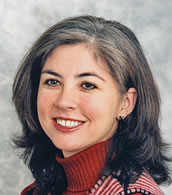Sinus Surgery Cutting Edge Technology
Michelle Facer, DO, MS
ENT/Otorhinolaryngology
Northern Pines Ear, Nose & Throat
Eau Claire
Facebook, Twitter, text messaging, Wii, GPS (global positioning systems such as Garmin and Tom Tom) are all buzz words that have become a part of our daily vocabulary. We have become a society who eagerly anticipates and demands the latest technological advances, and it is natural that these changes have occurred in the medical field as well.
One of the latest advances in surgical practice has been the develop-ment of image guided surgery. In the field of otorhinolaryngology, or Ear, Nose & Throat, image guided sinus surgery has proliferated over the last ten years.
“The advances in sinus surgery have allowed for more meticulous and complete surgical interventions and lessened the risks associated with the procedures.”
The resulting technology has been greatly beneficial for both patients and surgeons.
It is imperative to understand the history of sinus surgery to see how new technologies have created such significant changes. Originally, sinus surgeons accessed the sinuses by creating incisions in the skin overlying the sinuses. Those techniques and instruments are almost considered antiquated by today’s standards. For example, in order to open the ethmoid and frontal sinuses, surgeons would make incisions externally on the facial skin near the eye and eyebrow. In order to approach the maxillary sinus (the cheek sinus), surgeons created an opening above the gum line of the upper lip. A blunt instrument was then used to create a hole into the cheek sinus.
Eventually, new techniques to approach the sinuses were acquired. Surgeons began to open the sinuses directly by using headlights and instruments in the nose thus minimizing the need for external incisions. Loupes, or specialized glasses with magnification, aided visualization during procedures. In the 1950’s nasal endoscopes (small telescopes with a lighted camera on the end) were developed and implemented which led to major changes in the techniques of sinus surgery thus allowing more direct, much less invasive techniques to access the sinuses. The improvement in visualization as well as enhancements in instruments and surgical techniques expanded the procedures that could be performed. Endoscopic techniques allowed safe removal of nasal and sinus polyps, more precise and complete sinus surgery, and removal of both benign and malignant tumors involving the nose, sinuses and associated structures. Further progress in radiologic imaging led to better defined and understood anatomy.
All of these innovations then led to the development of image guided surgery. Originally, image guided sinus surgery required an external headgear which was worn by the patient at the time of surgery and coordinated with a CT scan of that particular patient’s sinuses. The latest system, which is now available at OakLeaf Surgical Hospital, no longer requires any external devices. Prior to surgery, a CT scan of the sinuses is performed. The images are stored on the system in the operating room. Once the patient is prepped for surgery, specialized instruments are used to trace bony landmarks on the patient’s face. These landmarks are specific to that patient’s anatomy and are coordinated with the CT scan information. Just as a navigation system guides a car using a map and coordinates, the image guided sinus system is able to guide the surgeon performing the procedure.
This becomes particularly important for patients who have had previous surgery, those with anatomical variants, those with sinus disease involving all of the sinuses (pansinusitis) or those patients with extensive polyps. The sinuses occupy a particularly important location within the head and neck. They are intimately associated with the eyes, the brain and major blood vessels. Complications of sinus surgery include injury to the eye muscles or the eye itself, blindness, cerebrospinal fluid leak, (the fluid that surrounds the brain) injury to the brain, bleeding and death. Image guidance allows the surgeon to see the patient’s specific anatomy as he or she is performing the procedure and minimizes the risks of complications. It is truly real time navigation and affords the surgeon an additional tool in his or her arsenal.
In addition, image guided sinus surgery can be used in conjunction with other advances such as balloon sinuplasty. These advances have maximized the precision of sinus surgery, allowed more complete removal of diseased tissue such as polyps, minimized bleeding and the need for packing, and relegated complications to a rarity. Subsequently, operative time has been reduced and the frequency of revision surgery has been lessened. This is particularly beneficial to the patient by decreasing the length of the procedure thus minimizing risks and costs. The need for overnight hospital stays and packing that must be removed in the office are virtually non-existent in my practice. Patient’s perceptions of sinus surgery and improvement in quality of life post-operatively are one of the main benefits of technological advances in sinus surgery.
Although huge advances have been made in medicine, this does not mean that older techniques no longer have a role. Our society may utilize text messaging and facebook, but the art of communicating by phone still exists. Sinus surgeons, as well, must have a thorough understanding of all techniques (image guided, endoscopic, direct visualization and external approaches) so that all options can be offered to patients based on each patient’s particular underlying anatomy, disease and history. Technology simply gives us new options to offer to our patients in the hopes of improving outcomes, minimizing risks and increasing patient satisfaction with the operative experience.
Dr. Facer, DO, MS –
Northern Pines Ear, Nose & Throat
For information or to schedule an appointment:
715.831.3300
Dr. Facer sees patients in Eau Claire.





 © 2009 OakLeaf Medical Network and OakLeaf Surgical Hospital. All rights reserved.
© 2009 OakLeaf Medical Network and OakLeaf Surgical Hospital. All rights reserved.